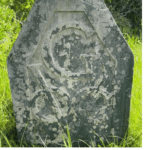Geelbek
Beacon in the West Coast National; park
The farm Geelbek, previously called Geelbekkenfonteijn, is situated at the southern end of Saldanha Baaij, now Langebaan Lagoon. In 1666 the French reported that the best and only really fresh water at Saldanha Bay was to be found at Geelbeksfontein where there was a group of fountains bubbling up. In 1669 the Dutch at Cape Town sent soldiers to guard the fountains to prevent the French from establishing a settlement there.
On Elphinstone’s map of Saldanha Bay 1795 (based on an earlier map), two buildings are shown at Geelbek.
About 500 m north-east of the farmhouse and not far from the shore of the lagoon there stands in the grassy veld about 35 steps from a row of gumtrees, a beacon of blue-black Malmesbury shale (from Robben Island) with the inscription G \VOC (The ‘G’ is for ‘Gemeen’, belonging to the Company in general and not to a particular Chamber and the VOC is for ‘Vereenigde Oostindische Compagnie’). The beacon is about 75 cm high, 40 cm wide and 20 cm deep.
In the absence of documentation, we are dependent on other means to determine the date of establishment.
Eighteenth-century beacons reflect the fashion and display of the Wig era; Van Plettenberg (Plettenberg Bay) and Van de Graaff (George Museum)’s VOC beacons from the late eighteenth century are ego documents, their personal names and ‘family weapons’ are engraved on them as prominently as the VOC badge.
Information on and source references to various VOC beacons in the Saldanha Bay area and on the islands, and specifically to a beacon near the fountain at Geelbeksfontein before 1760, appears in D. Sleigh:
Buiteposte, pp. 458-459.


